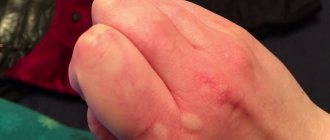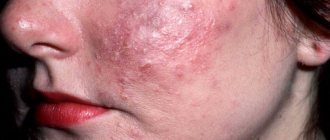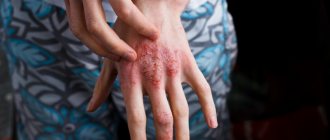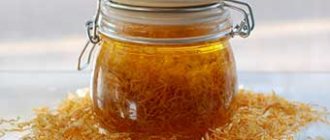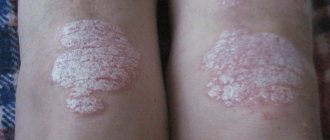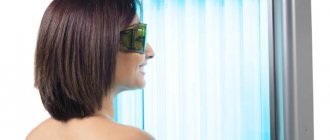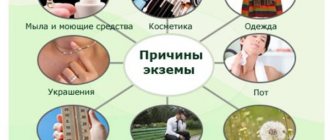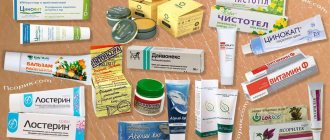Timely detection of the disease is the key to successful treatment. This rule is especially typical for those diseases that are very difficult to treat. These include scaly lichen, better known as psoriasis. Over the past decades, this disease has spread to increasingly large areas, affecting infants and pensioners, tilting the statistics in a sad direction. A 2014 WHO resolution called on states to inform the public about the symptoms, causes and course of psoriasis.
It is not for nothing that scaly lichen has aroused such serious interest. Today, from the classification of ordinary skin diseases, psoriasis has moved to systemic pathologies. It has been established that patients with this disease are more susceptible to infections, heart disease, depression, and diabetes. Given the lack of a unified treatment system, it is very important to identify psoriasis in the initial stages.
Symptoms of psoriasis on the arms and legs
Both on the legs and on the arms, psoriasis is similar in its symptoms. The following manifestations of the disease can be distinguished:
- thickening of the stratum corneum occurs;
- the skin quickly becomes rough;
- the epidermis is very dry;
- deep cracks appear;
- Red papules appear on the skin.
Often, psoriasis on the fingers and toes can trigger the development of a disease on the nails, in which they change color and structure. The photo clearly shows how psoriasis looks on the hands in the initial stage.
In place of papules, scales often appear, which constantly peel off. Everything is accompanied by severe itching or even burning. The symptoms of a dermatological disease are complicated by the fact that constant friction occurs in localized areas, which causes skin injury. The consequence of this may be the addition of an infection. The photo shows the initial stage of the disease on the feet.
Possible complications of chronic illness
With psoriasis, the skin ceases to perform its most important protective and regulatory functions. This increases the load on the heart and kidneys, leading to the following serious complications:
- Psoriatic arthritis is a lesion of the joints and soft tissues around them. It affects the fingers, toes, neck, lower back, and other areas of the body.
- Type 2 diabetes mellitus – the cells of the pancreas that produce insulin are destroyed.
- Obesity is associated with limited activity due to rashes on exposed skin.
- High levels of “bad” cholesterol, risk of heart attacks, atherosclerosis, heart failure.
- Kidney failure - due to inflammation, the kidneys stop filtering fluid well, and the body self-poisons.
- Skin cancer - due to taking steroid drugs for severe forms of psoriasis.
- Lack of folic acid - it is necessary for the synthesis of blood cells.
Types of psoriasis
There are several types of palmoplantar psoriasis:
- Typical. It is characterized by the appearance of plaques with clearly defined edges that protrude slightly above healthy skin. The rash is covered with a layer of dead silver cells. With a strong layer of dead tissue, cracking of the plaques occurs.
- Horny. Round-shaped rashes with a yellowish tint appear on the surface of the epidermis. The size of the rash ranges from insignificant small plaques to large expanding plaques.
- Vesiculopustular. Psoriasis manifests itself on the arms and legs with the appearance of single pustules or rashes of a large number of plaques. The lesions are located symmetrically.
In medical practice, there are two stages - remission and relapse. During the calm period, the skin may be clean, without rashes, or there will be isolated plaques on the surface of the dermis that do not cause discomfort. During a relapse, the number of psoriatic elements increases, and the inflammation is more pronounced.
Is it contagious?
Psoriasis is not a contagious disease; there is not a single case of transmission of the disease from a sick person to a healthy person. When communicating with a patient suffering from psoriasis, one may only experience a feeling of disgust and aesthetic discomfort. You cannot get psoriasis as a result of communicating with a patient who has rashes on the skin. Moreover, even with direct contact with the skin, with things, through the sweat and saliva of a patient with psoriasis, as well as during sexual contact, infection is completely excluded.
Antihistamines
These drugs are prescribed to relieve the unpleasant symptoms of psoriasis, namely itching and burning. The funds differ by generation:
- First generation. These medications have a fairly short antipruritic effect, so you have to take tablets up to 3 times a day. In addition, the product has a high sedative property. Such drugs include Suprastin and Tavegil.
- Second generation. They do not have sedative properties, but are contraindicated in cardiovascular diseases. The drug has a longer effect, so you can take the tablet once a day. These are Fenistil and Loratadine.
- Third generation. More modern drugs do not affect the functioning of the heart in any way. At the same time, the product is very effective and the action is long lasting. These antihistamines include Erius and Zyrtec.
Proper use of medications with an antihistamine effect can significantly alleviate the symptoms of the disease.
Interesting! Medicines that have a sedative effect are prescribed for sleep disturbances due to itching.
General principles of treatment
Complex treatment of psoriasis in the upper and lower extremities includes the use of the following methods:
- Drug therapy, including the use of drugs for oral and external use. For therapeutic purposes, tableted cytostatics are prescribed, and for external application to areas of psoriatic rashes, ointments and creams with glucocorticosteroids, phytoextracts and local anesthetics are used. Also, sprays that have anti-inflammatory, cooling and decongestant effects are widely used.
- Sanatorium-resort treatment (therapeutic baths, mud applications).
- Carrying out photochemotherapy.
- Physiotherapeutic treatment.
- Compliance with dietary recommendations and taking multivitamin complexes.
To treat psoriasis of the nail plates, the following drugs are used for external application:
- Advantan cream.
- Dayvonex ointment.
- Beloderm ointment.
- Anthralin cream or ointment.
Each product is applied to damaged areas 2 times a day and left until completely absorbed.
Medicines containing vitamin D3 help slow the progression of this disease. To prevent relapse of psoriasis, Xamiol gel, Rocaltrol capsules and Daivobet ointment can be used. Dermatotropic agents such as zinc and salicylic ointment help slow down the rate of skin cell division. Zorak gel or Tazorac cream will help reduce the intensity of inflammation.
Vitamins
Often, psoriasis can be a response to a lack of vitamins. Some microelements help to quickly get rid of the disease:
- Retinol. This vitamin helps improve metabolic processes and also prevents dry skin.
- Tocopherol. A powerful antioxidant that helps relieve inflammation and improve the condition of the dermis.
- Vitamin D. This element promotes faster restoration of damaged tissues and also improves metabolic processes.
- Group B. Helps restore the structure of the epidermis and also increases local immunity.
The following vitamin complexes can be identified that are suitable for therapy for the treatment of the disease:
- Aevit;
- Undevit;
- Revit;
- Duovit.
The course usually lasts one to two months, after which a break is required.
Forms
Hand psoriasis is divided into several forms.
Pustular
Typically affects the palms and forearms. Spots with purulent contents appear on the skin, forming “purulent lakes”. This is the most dangerous form of pathology, as it often leads to:
- extensive swelling of the palms;
- nephropathy;
- dystrophic phenomena.
teardrop-shaped
It most often occurs in the upper arms, near the shoulders. The shape of the plaques is similar to drops.
Plaque
With this form, plaques form in groups and become covered with white crusts.
Nail damage
Accompanied by the appearance of gray or white longitudinal or transverse hair. A thickening appears around the nail, the nail plate becomes loose and collapses.
By localization
Psoriasis also differs in localization:
- On the palms. The skin of the palms becomes red and rough, calluses and itching appear. This type of psoriasis can easily be confused with eczema or mycosis.
- On the fingers and bones of the hands. It manifests itself as inflammation and swelling of the fingers, cracking and peeling of the skin, itching and pain.
In the video below you can learn more about the forms of psoriasis:
Sedatives
Stress is a catalyst for the development of disease. Therefore, complex therapy includes taking sedatives. The most popular are the following pharmaceuticals:
- motherwort;
- valerian;
- Novo-passit;
- Persen.
In addition, these drugs eliminate the depressive state of patients, which inevitably accompanies every relapse of the disease.
Hormonal ointments
These are potent drugs that quickly and effectively cope with the disease. Typically, such ointments are prescribed during an exacerbation. The following means can be noted:
- Hydrocortisone ointment. It has an antipruritic effect and also effectively eliminates swelling.
- Celestoderm-V. The drug has a comprehensive effect on the disease, eliminating it in a short time. Eliminates peeling and redness on the skin.
- Sinaflan. Quickly relieves the symptoms of psoriasis, relieving itching and burning.
The disadvantage of the drugs is that they cannot be used for a long time, otherwise it can lead to atrophy of the skin.
Measures to prevent exacerbations
Due to constant skin contact with water and detergents, it is quite difficult to cure psoriasis of the fingers forever.
In addition, exacerbations are often provoked by a psycho-emotional breakdown. Simple rules will help keep psoriasis symptoms under control:
- positive attitude - understand that psoriasis does not make you worse than others, learn to live with it;
- clothing made from natural fabrics in a light shade - so that the skin breathes and flaky plaques are not so noticeable to others;
- Following special dietary recommendations will relieve intoxication and strengthen the immune system;
- active lifestyle - spend more time in nature, visit the gym, swimming pool;
- skin care - air baths, douches, massage, special creams and cosmetics;
- taking medications only after consulting a doctor.
Non-hormonal ointments
These are ointments of a milder action. They act on the surface of the skin without penetrating into the blood. The composition includes natural ingredients or a medicinal active substance of a non-hormonal nature. The most popular ointments can be noted:
- Salicylic;
- Daivonex;
- Naftalan;
- Tsinocap.
These drugs are not as strong as steroids, so the effect will only be noticeable after a couple of weeks of use. Medications are prescribed for a long time.
Important! It is strictly forbidden to prescribe medications on your own; before starting therapy, you should consult a specialist.
Causes of psoriatic hand lesions
The mechanism of psoriasis has not been fully established, but it has been found that it is caused by a violation of skin cell division, in which diseased cells begin to multiply and grow 5-10 times faster. Soon, immune cells join the process and blood vessels grow.
After the cells die off, keratinized areas remain on the smooth surface of the skin - convex psoriatic plaques. In addition to genetic predisposition - characteristics of immunity, skin structure, indirect causes have been identified that influence the initiation of the development of psoriasis.
These are:
- prolonged exposure to unfavorable climatic factors - cold, wind, dry air, low humidity, sunlight;
- psycho-emotional overload, stress;
- taking anticonvulsants, sedatives, antimalarials, beta blockers;
- thyroid diseases, neurological disorders;
- burns, frostbite, mechanical injuries to the soft tissues of the hand - abrasions, cuts, scratches;
- the presence of chronic infections, intoxication of the body, weakened immunity;
- improper, unbalanced diet;
- tendency to an allergic reaction;
- excessive hygiene - the use of products that make the skin dry and deprive it of its natural protection;
- smoking, alcohol abuse.
Physiotherapy
The following physiotherapy procedures are often used as an additional effect on the disease:
- magnetic therapy;
- phototherapy;
- laser exposure;
- cryotherapy.
All these procedures are aimed at relieving symptoms and maintaining remission. However, there are contraindications and restrictions for use.
Reviews
Dear readers, was this article helpful? What do you think about such a disease as psoriasis under the arms and the methods of its treatment presented? Leave feedback in the comments! Your opinion is important to us!
Anton
“I can recommend an effective way to treat psoriasis using bay leaves. We tried the decoction on ourselves, it helps one hundred percent.”
Alina
“The main thing with psoriasis is to eliminate the effects of stress; it is nerves and emotional shocks that most often provoke outbreaks of psoriasis.”
Rules for caring for hands and feet
During an exacerbation of psoriasis on both the arms and legs, the skin requires special care:
- Do not wash your hands and feet with hot water.
- When using household chemicals, you must wear rubber gloves.
- After washing your hands, it is recommended to moisturize your skin with neutral products.
- You should also wear breathable cotton socks.
- Shoes should be spacious.
By following these simple rules, you can significantly bring the onset of remission closer. Treatment of psoriasis on the arms and legs is a long and painstaking process, since the skin in these places is constantly susceptible to damage. But timely contact with a specialist and properly selected therapy guarantee quick and lasting results.
Diet
The number of exacerbations of psoriasis largely depends on diet. It is important for patients with this disease to consume more foods that can alkalize the internal environment of the body. To do this, you need to increase the proportion of vegetables, herbs, various cereals, and dried fruits in your diet. It is important to have adequate intake of animal and plant proteins, as well as polyunsaturated fatty acids.
It is necessary to drink at least seven glasses of water daily and completely avoid alcohol. It is important to keep sweets, salt, citrus fruits, fatty dairy products, chocolate and honey to a minimum.
